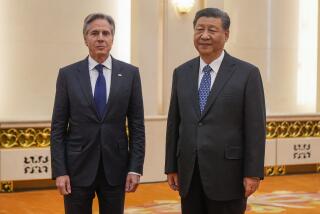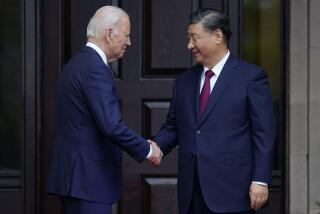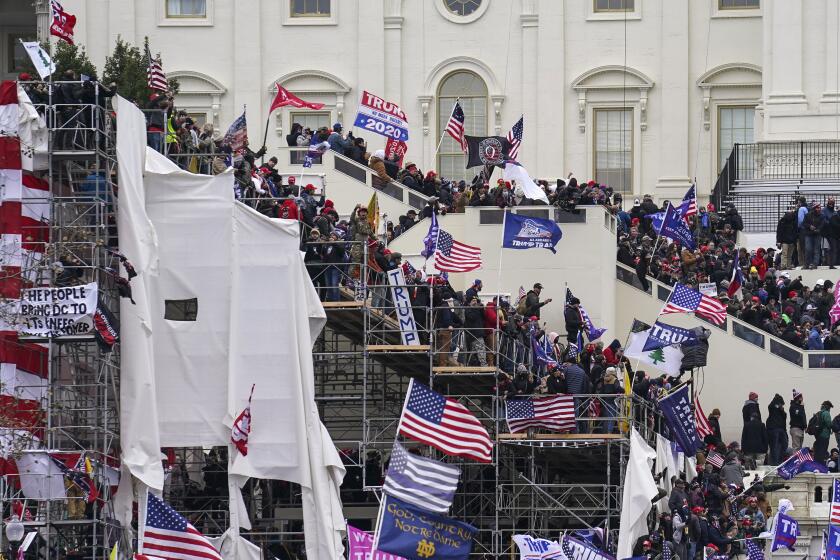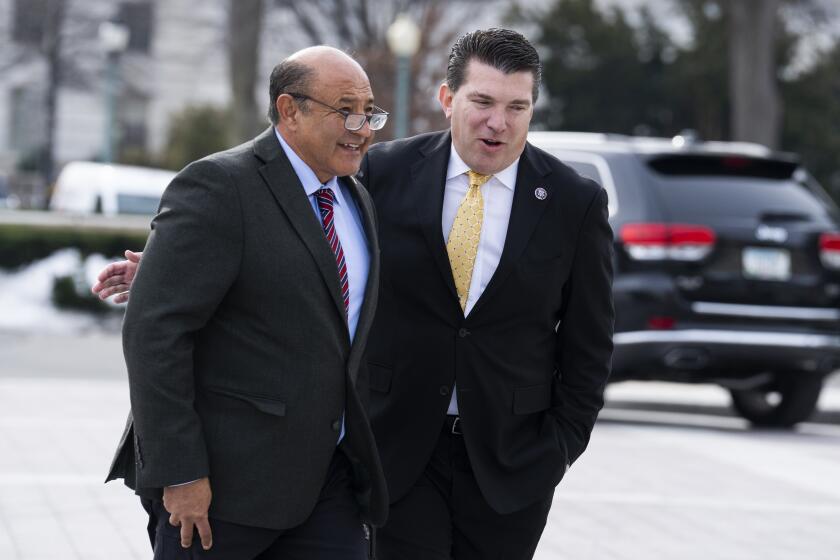Trump and Xi agree to restart trade talks and put a hold on new tariffs

President Trump has agreed to restart trade talks with China and hold off new tariffs and certain restrictions on the star Chinese technology firm Huawei, marking the latest ceasefire in his roller-coaster trade battle with Beijing.
Trump made the announcement Saturday after meeting with Chinese President Xi Jinping at the Group of 20 economic summit in Japan. Trump said the Chinese, for their part, will be buying a “tremendous amount” of U.S. farm and food products, though neither he nor Xi offered any details about this pledge.
Taken together, the actions appear likely, for now, to deescalate trade tensions that had been threatening the world economy. By themselves, however, they do not bring the two sides closer to narrowing the key gaps underlying their dispute, such as U.S. demands for structural changes in China’s state-controlled economy.
“The fundamental issues of U.S.-China trade conflict are still unresolved, though both Trump and Xi could go home to give hope to their constituents, assuring they will be resolved in the end,” said Ho-fung Hung, professor of political economy at Johns Hopkins University.
Beijing had said that a precondition for reaching a trade deal would be a reversal of the Trump administration’s blacklisting of Huawei Technologies Co. on national security grounds.
A few days after U.S.-China trade talks broke down in May, the Commerce Department placed Huawei on its so-called entity list, making it very difficult for U.S. firms to sell critical chips and other components to the telecom giant.
Huawei is a global leader in the development and manufacturing of the next-generation 5G mobile networking equipment, and its status has become a linchpin in a widening dispute between the two countries over trade, technology and security matters.
Trump did not remove Huawei from Commerce’s entity list, and the company faces other U.S. restrictions as well. Trump said, however, that Huawei would be a matter for consideration at the final stage of the trade talks.
Lawmakers from both parties had urged Trump to keep separate security concerns such as Huawei from trade negotiations.
Last year, the president was sharply criticized after, as a favor to Xi, he gave a reprieve to another, smaller Chinese telecom firm, ZTE, which had been cut off from U.S. parts by the Commerce Department for violating sanctions against Iran and North Korea.
On Saturday, Trump left somewhat vague exactly what Huawei would be allowed to buy, but his statements drew immediate fire from members of Congress.
“If President Trump has in fact bargained away the recent restrictions on #Huawei, then we will have to get those restrictions put back in place through legislation,” tweeted Sen. Marco Rubio (R-Fla.).
Trump defended his decision on Huawei as good for America’s business.
“We sell to Huawei a tremendous amount of product that goes into the various things that they make, and I said that’s OK, we will keep on selling that product. These are American companies,” Trump said during a news conference that lasted more than an hour at the close of the G-20 summit.
In an apparent exchange, Trump said , China would be buying a large but unspecified amount of U.S. agricultural products even as the two sides negotiate.
“We’re going to give them lists of things we want them to buy,” Trump said. “It’s going to be great for our farmers.”
China’s official statement on the talks published Saturday on the state-owned Xinhua news agency said Trump and Xi agreed to resume trade talks “on the basis of equality and mutual respect.”
But there was no joint statement of what Trump and Xi agreed to, and it is not clear how the two sides would interpret such language. Also, there were questions about what pledges the Chinese made on farm purchases, which Beijing has repeatedly offered in the past.
“The lack of formal statements and the disagreement already on Chinese ag commitments aren’t a good sign,” said David Loevinger, an analyst for TCW Emerging Markets Group in Los Angeles and a former senior Treasury Department official for China affairs.
U.S. and Chinese trade officials have been negotiating on and off for more than a year, but talks broke off about two months ago after U.S. officials accused China of walking back commitments that they had previously made. Trump then announced an increase in tariffs on $200 billion of imports from China, which took effect in May.
Trump also threatened to slap tariffs on roughly $300 billion more of Chinese goods, and the U.S. trade representative held five days of public hearings recently as part of the formal process before the new tariffs could be applied.
In all, Trump has imposed 25% tariffs on about $250 billion of Chinese products — and those have not been lifted. China’s retaliatory tariffs on about $110 billion of U.S. goods also remain in place.
It wasn’t clear when trade talks would resume, and unlike past moves in which Trump called off tariffs, there was no deadline set on when a deal would need to be reached before the threat of duties is reinstated.
Saturday’s meeting between Xi and Trump was held on the sidelines of the G-20 summit of major economies, and it carried high drama as world leaders gathered in Osaka, Japan, openly fretted about rising trade friction and the potentially devastating effects it could have on a fragile global economy.
G-20 leaders welcomed the news that the United States and China would be restarting talks. So did U.S. retail and other business groups, which had warned that a further escalation of tariffs would hurt American consumers with higher prices and cause significant damage to businesses and the economy.
“We hope each side is now prepared to go the last mile to achieve a high-standard, comprehensive, enforceable agreement,” Myron Brilliant, the U.S. Chamber of Commerce’s head of international affairs, said in a statement. “China must commit to addressing longstanding unfair trade practices and industrial policies that prevent a level-playing field for U.S. companies.”
Whether a resumption of negotiations will lead to such an agreement is highly uncertain.
Trump’s chief trade official, Robert Lighthizer, has insisted that China must make concessions that will protect America’s intellectual property and innovations, and do so in a way they can be monitored and enforced.
Trump, however, has tended to focus less on systemic problems and much more on securing large Chinese purchases and narrowing the U.S. trade deficit.
“China is willing to talk but not to change,” said Andy Xie, an economist based in Shanghai. “China can live with purchases of energy and ag products and selecting market openings for U.S. companies — not structural change.”
Trump’s latest meeting with Xi and decision to back away from more tariffs had a deja vu quality to it.
On the sidelines of the last G-20 meeting in December, in Buenos Aires, Trump had a dinner with Xi and then backed off his threat to raise tariffs on Jan. 1. That truce gave negotiators another 90 days, and in February, Trump pushed out the deadline again indefinitely. When talks fell apart in May, Trump went ahead and raised tariffs.
This time, on the concluding day of the G-20 summit in Osaka, it was after a lunch-hour meeting with Xi that Trump cut the deal to call off a new round of tariffs, on $300 billion of Chinese goods.
At the start of their meeting, inside a room in Osaka’s exhibition and convention center, the two leaders sat at a long table, with Trump and Xi facing each other, aides flanked to the right and left.
Xi began by referring to the so-called ping-pong diplomacy that began in 1971 that eventually led to the establishment of diplomatic relations between the United States and China in 1979.
“China and the United States both benefit from cooperation, and lose from confrontation,” Xi said.
Trump, in his opening remarks, fondly recalled his November 2017 state visit to Beijing when Xi rolled out the red carpet for him. Trump called the visit “one of the most incredible of my life.”
“We have had a lot of time together. We’ve become friends,” Trump told Xi, before turning to the matter of trade. “We’re totally open to it,” he said of a “fair trade deal.”
David Lampton, a fellow at the Asia-Pacific Research Center at Stanford University, said what happened at the G-20 in Osaka followed a familiar pattern.
“Excessive threats, followed by bluster, followed by retreat to where you started, except U.S. credibility [is] diminished further in the process,” he said. “Xi is running out the clock, hoping to get to a new U.S. administration.”
Robyn Dixon and Alice Su in The Times’ Beijing bureau contributed to this report.
More to Read
Get the L.A. Times Politics newsletter
Deeply reported insights into legislation, politics and policy from Sacramento, Washington and beyond. In your inbox three times per week.
You may occasionally receive promotional content from the Los Angeles Times.







